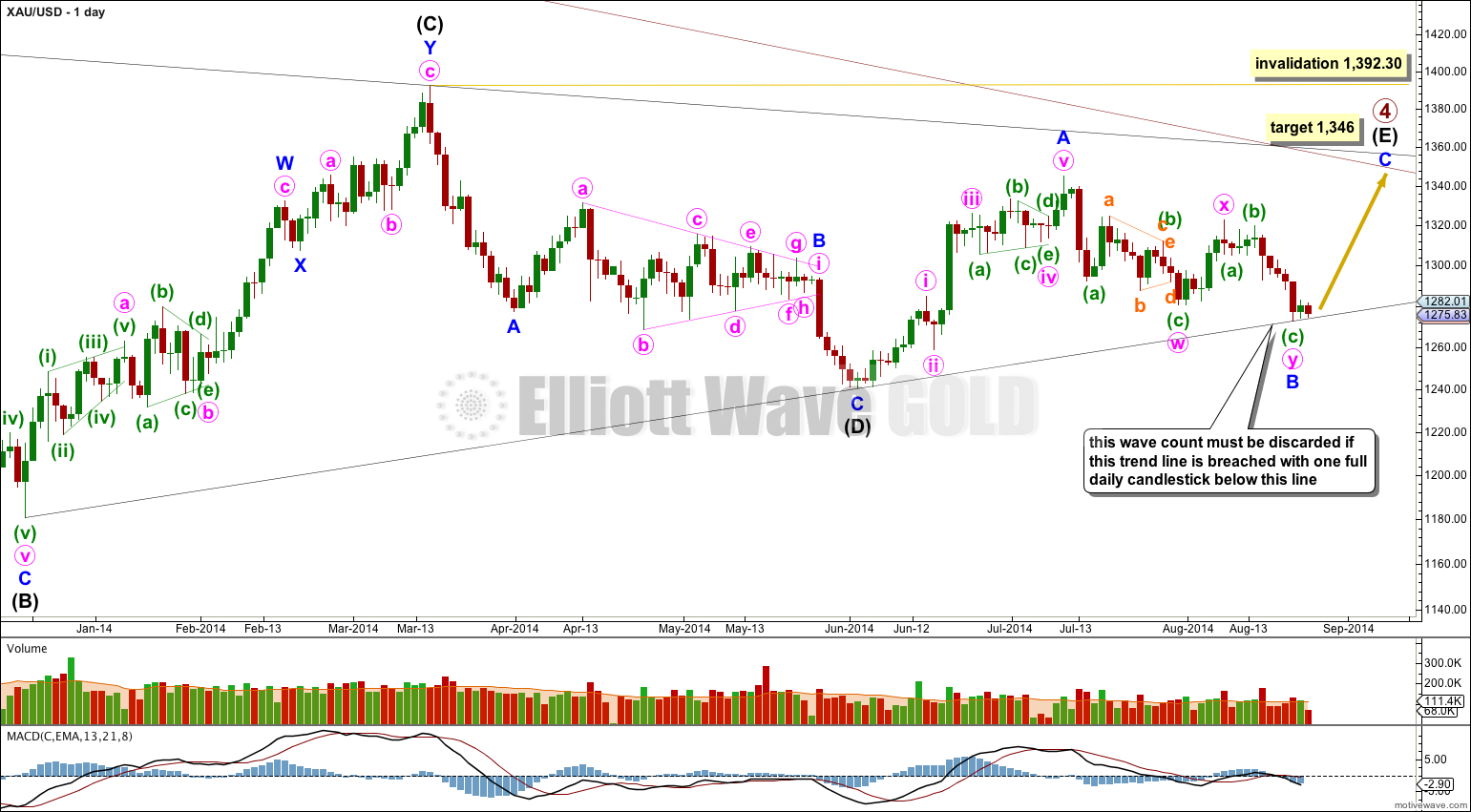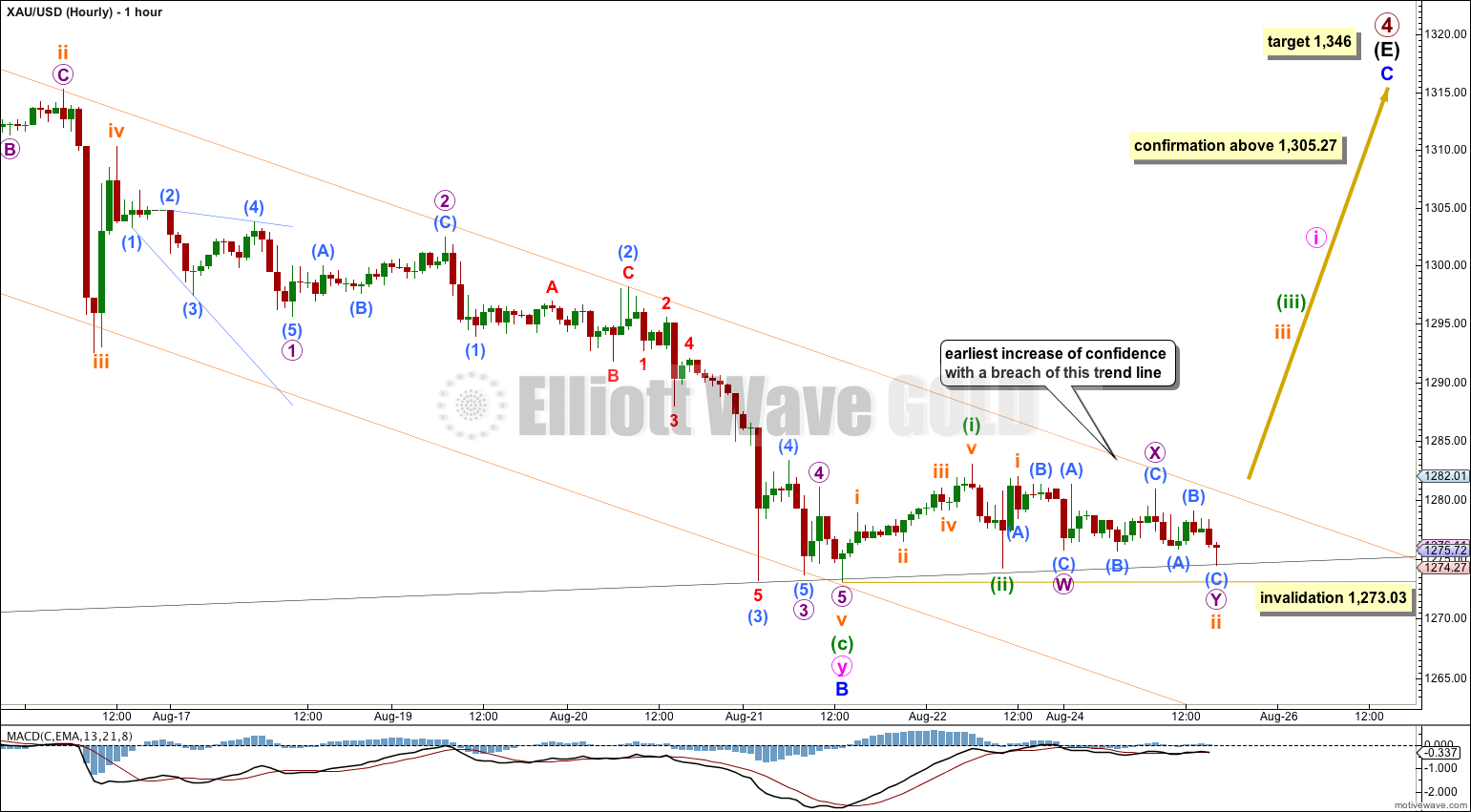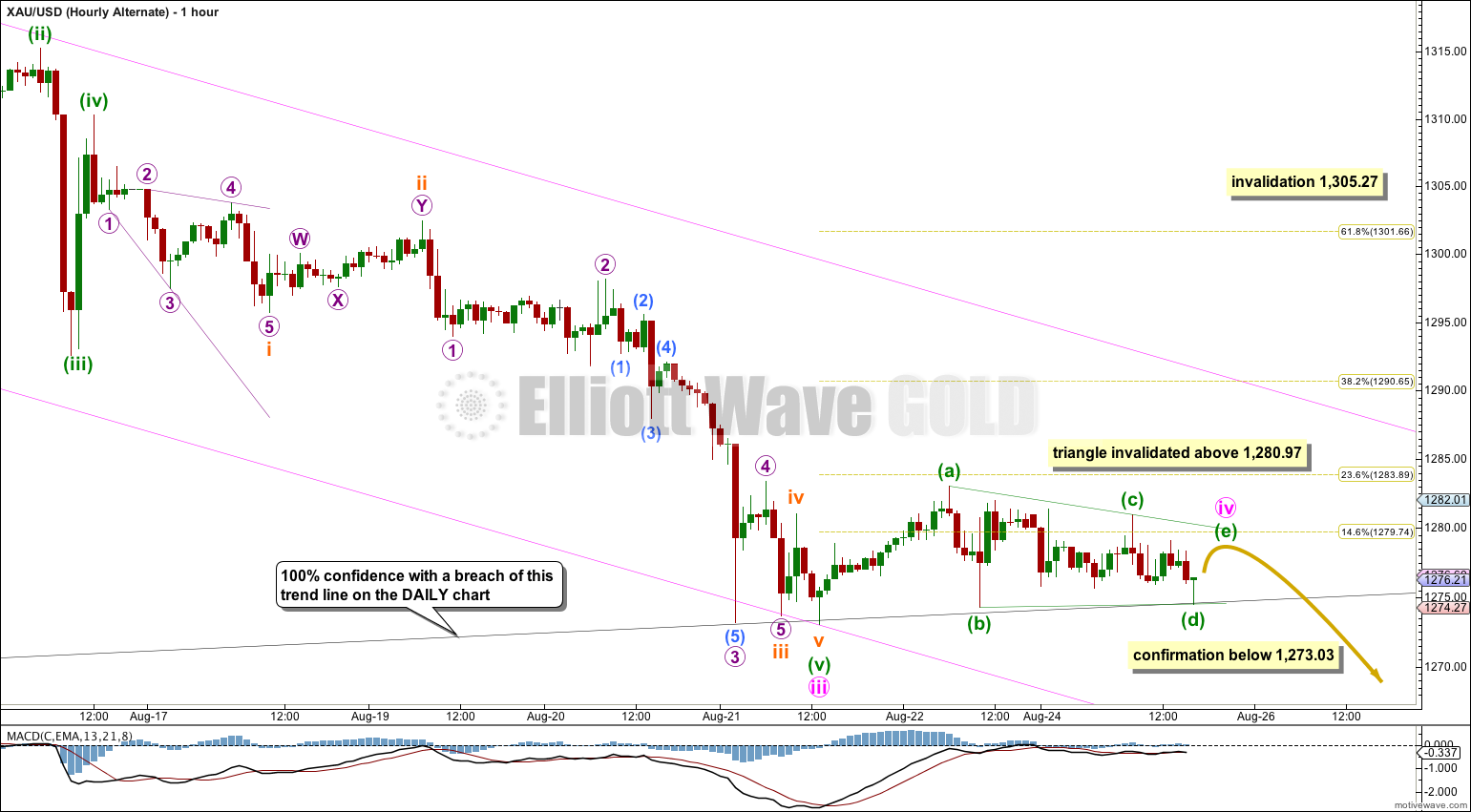The (B)-(D) trend line of the primary wave 4 triangle continues to provide strong support. The main Elliott wave count still has a higher probability.
Summary: The breakout is most likely to be upwards when price breaks out of this sideways move it has been in for two trading days now. A new high above 1,305.27 would provide strong confidence in the target at 1,346. That target may be met in another 11 trading days. Alternatively, a new low below 1,273.03 would indicate a new primary degree trend to the downside. Full confidence in a new primary degree trend to the downside would come with one full daily candlestick below the (B)-(D) trend line.
Click on charts to enlarge.
Main Wave Count.
Primary wave 4 is an incomplete regular contracting triangle. Primary wave 2 was a deep 68% running flat correction. Primary wave 4 is showing alternation in depth and some alternation in structure.
Within the triangle of primary wave 4 intermediate wave (E) is unfolding as a zigzag: minor wave A is a five wave impulse and minor wave B downwards now fits as a completed double zigzag.
There are four nice examples of completed triangles on this daily chart. When triangles are complete the first movement out of them is most often quite swift and sharp. Importantly, this first movement does not hesitate at the B-D trend line and will plough straight through the trend line, which ceases to provide support or resistance. It is significant that at this stage the (B)-(D) trend line is still providing support to downwards movement. This is one reason why I consider this main wave count to have a higher probability.
If minor wave C is to avoid a truncation it should move above the end of minor wave A at 1,345.22. At 1,346 it would do this, and may end when price comes to touch the upper edge of the maroon channel copied over here from the weekly chart. This may see minor wave C last a Fibonacci 13 days in total.
The four examples of completed triangles here on the daily chart also show that the final subwave of a triangle most often ends comfortably short of the A-C trend line. The target at 1,346 would see this happen for primary wave 4.
Intermediate wave (E) may not move beyond the end of intermediate wave (C) above 1,392.30.
Sideways movement of the last two days fits nicely as two overlapping first and second waves. This wave count expects to see some increase in upwards momentum as a third wave up begins, which should have the strength to break through resistance at the upper edge of this channel.
A clear breach of the upper orange trend line would increase confidence in this main wave count a little.
Minuette wave (c) does not fit into a channel drawn using Elliott’s techniques. This channel is a “best fit”, and the upper trend line particularly does seem to be showing nicely where price is finding some resistance. When this trend line is clearly breached that shall be the first indication that this wave count may be correct and confidence will increase at that point.
Movement above 1,305.27 would provide full invalidation of the alternate at the hourly and daily chart levels and would provide full confidence in this main wave count and the target. This may happen next week.
Within minor wave C no second wave correction may move beyond the start of its first wave below 1,273.03.
Alternate Daily Wave Count
It is possible that primary wave 4 is over at the high of 1,345.22. This wave count still requires confirmation with a clear breach of the (B)-(D) trend line on this daily chart.
If primary wave 4 is over then primary wave 5 downwards would reach equality in length with primary wave 1 at 956.97. Primary wave 1 was a remarkably brief 3 weeks duration. I would expect primary wave 5 to last some months, and is already longer than one month.
The only structure which fits for minor wave 1 is a leading contracting diagonal. While leading diagonals are not rare, they are not very common either. This slightly reduces the probability of this wave count.
Within diagonals the second and fourth waves are commonly between 0.66 to 0.81 the prior wave. Here minute wave ii is 0.61 the length of minute wave i, just a little shorter than the common length, slightly reducing the probability of this wave count. Minute wave iv is 0.66 the length of minute wave iii, just within the common length.
Leading diagonals in first wave positions are normally followed by very deep second wave corrections. Minor wave 2 is deep at 65% the length of minor wave 1, but this is not “very” deep. This again very slightly reduces the probability of this wave count.
The biggest problem I have with this wave count and the main reason for it still being an alternate is the leading diagonal following the end of the triangle for primary wave 4. When triangles end the first piece of movement out of the triangle is almost always very strong and swift. Diagonals are not strong and swift movements. To see a first wave out of a triangle subdividing as a diagonal is highly unusual and does not at all fit with typical behaviour.
Also, price continues to find strong support at the (B)-(D) trend line, which should have ceased to provide any support or resistance if the triangle was over. This is unusual and further reduces the probability of this alternate wave count.
Within minor wave 3 minute wave iv may not move into minute wave i price territory above 1,305.27.
A clear breach of the lower (B)-(D) trend line of the primary wave 4 triangle would provide full and final confirmation of this alternate. A full daily candlestick below that trend line would provide me with 100% confidence in this wave count.
This wave count and the main hourly wave count see the subdivisions of recent movement in the same way: A-B-C and 1-2-3 have exactly the same subdivisions.
The channel drawn here uses Elliott’s first technique: draw the first trend line from the lows of minute waves i (see that from the daily chart now) to iii, then place a parallel copy on the high of minute wave ii (also on the daily chart now). I would expect minute wave iv to find resistance at the upper pink trend line. If this trend line is breached this wave count will further slightly reduce in probability, but fourth waves are not always contained within these channels and just a breach does not invalidate this wave count. Only movement above 1,305.27 would do that.
Minute wave ii was a very deep 82% double combination. Minute wave iv looks like it may be unfolding as a regular barrier triangle which only needs the final wave of minuette wave (e) to complete it. Minuette wave (e) may not move beyond the end of minuette wave (c) above 1,280.97.
Fifth wave behaviour following barrier triangles is either a very brief sharp movement, or a very long extension. In this case I would expect a very long extension for minute wave v so that minor wave 3 ends far enough below the end of minor wave 1 to allow room for upwards movement of minor wave 4.
Minute wave ii lasted three days and minute wave iv should be about the same duration, so that their proportions are somewhat similar and the wave count has the right look. If this wave count is correct we should see confirmation within the next 24 hours now.
Any movement at any time below the black (B)-(D) trend line would immediately increase the probability of this wave count. A full daily candlestick below that trend line would see the main wave count firmly discarded in favour of this alternate. I expect that is quite unlikely.
After further analysis and judgement I would consider this alternate (or any variation of it which sees primary wave 4 as over) to have only about a 20% probability, with the main wave count an 80% probability.
This analysis is published about 05:28 p.m. EST.




